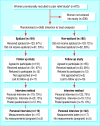Randomised study of long term outcome after epidural versus non-epidural analgesia during labour
- PMID: 12183305
- PMCID: PMC117883
- DOI: 10.1136/bmj.325.7360.357
Randomised study of long term outcome after epidural versus non-epidural analgesia during labour
Erratum in
- BMJ 2002 Sep 14;325(7364):580
Abstract
Objective: To determine whether epidural analgesia during labour is associated with long term backache.
Design: Follow up after randomised controlled trial. Analysis by intention to treat.
Setting: Department of obstetrics and gynaecology at one NHS trust.
Participants: 369 women: 184 randomised to epidural group (treatment as allocated received by 123) and 185 randomised to non-epidural group (treatment as allocated received by 133). In the follow up study 151 women were from the epidural group and 155 from the non-epidural group.
Main outcome measures: Self reported low back pain, disability, and limitation of movement assessed through one to one interviews with physiotherapist, questionnaire on back pain and disability, physical measurements of spinal mobility.
Results: There were no significant differences between groups in demographic details or other key characteristics. The mean time interval from delivery to interview was 26 months. There were no significant differences in the onset or duration of low back pain, with nearly a third of women in each group reporting pain in the week before interview. There were no differences in self reported measures of disability in activities of daily living and no significant differences in measurements of spinal mobility.
Conclusions: After childbirth there are no differences in the incidence of long term low back pain, disability, or movement restriction between women who receive epidural pain relief and women who receive other forms of pain relief.
Figures
Comment in
-
Epidurals and backache: again?BMJ. 2002 Nov 2;325(7371):1037. doi: 10.1136/bmj.325.7371.1037/b. BMJ. 2002. PMID: 12411376 Free PMC article. No abstract available.
References
-
- Chamberlain G, Wraight A, Steer P. Pain and its relief in childbirth. The results of a national survey conducted by the National Birthday Trust. Edinburgh: Churchill Livingstone; 1993.
-
- Scott DB, Hibbard BM. Serious non-fatal complications associated with extradural block in obstetric practice. Br J Anaesth. 1990;64:537–541. - PubMed

